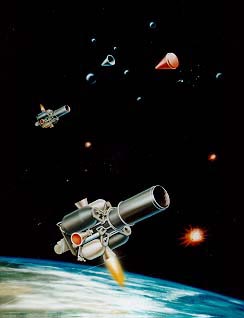ContentZone

Raytheon is under contract to deliver a sensor platform and space-based weapons platform for testing, and could well enter final production in the year 2000 should it demonstrate its viability to the Department of Defense's Ballistic Missile Defense section.
The weapons platform, known as an Exoatmospheric Kill Vehicle (EKV), will be controlled by the Ground Based Interceptor (GBI), which is the key element in a National Missile Defense (NMD) deployment.
The NMD system consists of six elements:
Less SMTS, all elements are being matured at a pace to support an integrated system test in late 1999. In the case for SMTS, a Flight Demonstration system Satellite (FDS) will act as a surrogate to support the integrated test.
The NMD program is structured as a deployment readiness program, which specifies three years to develop and test the NMD elements. At the end of these three years, a decision will be made based on the existing or projected threat to deploy a treaty-compliant NMD system. The deployment should then take an additional three years.
In the case in which a decision to deploy is not made, the GBI project will continue to develop the required ekv sub-elements in order that a capable missile defense system could be deployed if and when required. Specifically, an EKV will be developed and flight-tested for the NMD interceptor system which can accomplish intercepts of high-speed, long-range Intercontinental Ballistic Missile (ICBM) reentry vehicles (RVs) in the midcourse of their trajectories. Since exoatmospheric intercept is the key to an effective NMD system, an interceptor will be developed to be capable of acquiring a threat cluster, then discriminating those elements within the target cluster, selecting the RV, and destroying it by kinetic force.
The interceptor must be capable of combining NMD system sensor information with the scene its on-board seeker observes and selecting the lethal object for its target. If sufficient information is not available from the NMD system, the interceptor must be able to determine autonomously the lethal object via its on-board discrimination and target selection capability.
The GBI project takes advantage of prior Ballistic Missile Defense Organization (BMDO) interceptor investments and accomplishments to complete development and fly the Exoatmospheric kinetic Kill Vehicle or EKV portion of the interceptor.
The EKV is the smart, non-nuclear, hit-to-kill sub-element of the GBI element of the total six-element NMD system. The ekv contains the on-board optical seeker, data processing, guidance and divert propulsion required to intercept long-range ballistic missile RVs in the mid-course portion of the their flight trajectories. Target destruction is accomplished by direct impact of the ekv and the resulting transfer of its kinetic energy to the RV target (hit-to-kill).
Significant progress has been made to develop and integrate the technologies necessary to demonstrate with confidence that the destruction of a RV can be made by killing "a bullet with a bullet." What remains to accomplish is validating both sensor and ekv performance via flight tests.
By the year 2000, flight tests will demonstrate NMD interoperability between the EKV, on-line BM/C3, the NMD Radar Technology Demonstrator (RTD) and on-line medium wavelength infrared (MWIR) SMTS. Flight testing will confirm the GBI's ability to intercept representative targets under real engagement conditions, reliably and repeatedly. Most importantly the interceptor, via its associated EKV, must be able to determine the lethal object through on-board discrimination and target selection.
EKV Test Successful; Unidentified Celestial Objects Tracked
Raytheon's January 16th, 1998 space test of an Exo-atmospheric Kill Vechicle (EKV) sensor platform for a "Star Wars" type system proved successful in collecting necessary data on the system's performance. The sensor successfully detected the 9 targets (8 decoys and one genuine target) as well as the Lockheed-Martin Multi-Service Launch System (the "bus") which boosted the 9 test targets into orbit.
But the Raytheon space sensor detected a total of 12 objects in all, so some other "things" were apparently hanging around.
One of the remaining three objects was a Lockheed Martin Astronautics Multi-Service Launch System ( MSLS ), which lofted nine conical- and spherical-shaped targets into space. The other two sensor-detected items could only be described as "unidentified celestial objects," according to Raytheon officials, who would not speculate on what they might be. More importantly, the "real" RV was identified and tracked successfully.